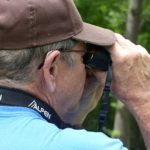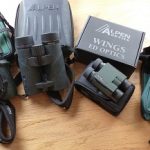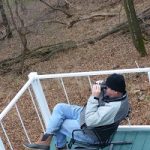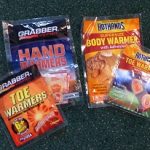by Winding Pathways | May 3, 2020 | Birds, Nature
Can you introduce kids to bird watching and get “outside” during novel coronavirus times?
We read a short article written by a diehard baseball fan. She had bought season tickets to her beloved St. Louis Cardinals just before the pandemic hit. When the virus shut down baseball she said, “I’m not watching the Cardinals but I am loving the cardinals……the ones that sing in my backyard.”
Like the baseball fan, many people are enjoying birds in their yards and neighborhoods – often for the first time. Birding is an outstanding hobby and this spring is an outstanding time to start. Being confined to the house and yard is a great opportunity to introduce kids to birds. Also, usually, the best birding of the year is in early May when avian migrants move through and visitors from the far south nest nearby.
Birding requires no license. There isn’t a closed season. Enjoying birds is free and can be done everywhere, even in the biggest cities. It’s a hobby that can be started simply and may evolve into a lifelong passion.
Basic Homebound Birding with Kids

Bird watching is again a joy with hearing aids.
Cost: nothing.
Special equipment needed: None, but a pencil and a few sheets of scrap paper can help record observations.
Encourage kids to watch birds in the yard. Most can identify cardinals, blue jays, and house sparrows but distinguishing species for a beginner isn’t essential. Just have kids note how one type of bird looks and acts differently than others. Essentially how a cardinal differs from a sparrow. Maybe have the kids sketch the birds they see.
The Next Step
Cost: Around $125 for entry-level binoculars and a basic bird book.
Equipment: Binoculars and a bird book and bird apps:
At this stage begin identifying and recording species seen. Read with a child descriptions of the life history, migration patterns, and habitat of different species.
List all the birds seen in the yard. This is the start of a “life list”.
A Little More Advanced
Cost: Not much. The basic equipment listed above works but add in a few dollars for gas to visit nearby habitats.
After a child can distinguish between backyard bird species and has used a bird book or app it’s time to search for more species. Bring along binoculars and a pad and pencil. Visit nearby wetlands, woodlands, and grasslands. Even with novel coronavirus shutdowns, most places allow people to visit parks and natural areas. Each will feature new bird species. Take note of them and read about each. Add new species to the list started with backyard birds.
Igniting a Passion
Most children are curious about nature and seeing just one or two fascinating birds can ignite a lifelong passion that may become a delightful hobby or even a professional career. Advanced birders purchase sophisticated optics and travel the world to see new species and learn more about these fascinating animals. Hopefully, the novel coronavirus will pass soon and the world opens to a youngster with a new birding hobby. It all can start by spotting a blue jay in the backyard.
Where to Get Information
At Winding Pathways, we have many paper bird books produced by several companies. We don’t favor one over the other but often refer to several when we’re trying to identify a bird new to us. Increasingly we rely on the Merlin App created by the Cornell Laboratory of Ornithology. The descriptions of hundreds of bird species, along with photos and calls, is at the tip of our fingers on our iPhones. It’s free. Simply go to the App Store and search for Merlin. The Lab of Ornithology has many other fascinating resources that can be accessed from a computer or smartphone, and we love their paper magazine Living Bird.
The National Audubon Society is highly bird-oriented and has local chapters. Attending a meeting or going on a birding excursion with members is an outstanding way to connect with people who share a bird passion. Some chapters may offer ZOOM meetings. Others hold online excursions to help people get and stay connected. Earth Day saw a host of events online.
We also enjoy reading Bird Watcher’s Digest, a small format magazine that features articles about individual species and places to enjoy them in every issue. The Internet is loaded with many other bird resources.

Alpen optics are good quality with good value.
We are often asked what type of binoculars we use. None of our optics is high end. Rich prefers 8X42 power while Marion’s are 10X42. The first number is the magnification and the second indicates how much light enters the optic. Eight or 10 powered binoculars that give a clear view and fit well in someone’s hands are ideal for a budding birder. Tiny micro binoculars are great for travel but we find them much harder to use than larger ones.
Spring is the best time to see migrating birds, and the novel coronavirus is confining people to yards. It’s an opportunity to take notice of the colorful and interesting wildlife that comes to us. This is a wonderful time for a child to launch a birding hobby.
by Winding Pathways | Nov 16, 2017 | Travel/Columns
TRAVELING WITH BINOCULARS
Disclosure: Years ago we were asked to serve on the Alpen Optics Birding Pro-Staff and periodically we receive optics to test. Following is a report on using mini-binoculars while traveling.
In October we enjoyed a 1600-mile, 12-day clockwise loop around Washington State. After picking up our rental car at the Spokane airport our journey took us through deserts, mountain passes, the Olympic rainforest, and even across Puget Sound on a ferry.
We enjoyed spotting new bird species, sea lions, jellyfish, Roosevelt elk, and a host of other wildlife. Good thing we brought along binoculars! We wouldn’t dream of traveling without binoculars and use them constantly. Even when we trek to New York City we tote along a pair. But, for this trip, they presented a dilemma.
We wanted to avoid checking baggage on the plane to save cost and the possibility of a lost suitcase.

Rich with compact binoculars.
Delta Airlines limited us to a small suitcase that we could carry on the plane. Squeezing nearly two weeks’ worth of clothes and supplies into these packs was a challenge. It became obvious that we couldn’t fit in our full-size binocs. Mini Binoculars to the rescue! Our Alpen Wings ED compact binoculars easily nested into a hiking boot that we tucked in the pack.
For all around general binocular use, and when we’re traveling by car, we always use full-size binoculars. They fit our hands well, provide a bright image, even at dawn and dusk, and their field of view is wide. Their downside is bulkiness.
Many optical companies sell high-quality compact binoculars. Go for quality. Inexpensive models are nearly useless. Here are the pros and cons of mini binoculars:
PRO
Compact binoculars are handy because they are small. They easily fit in a glove compartment, purse, or jacket pocket and take little space in a suitcase. Mini’s are ideal for travel. Quality ones have clear optics.
Having a pair of mini binoculars handy is always better than not having binoculars.
CON
Mini binoculars have a limited field of view and are rarely as good in low light situations as their full-size cousins. We find them a little harder to use and hold than full-size models and would never choose to use minis for long viewing sessions or if we went on specific birding excursions. But they are invaluable when size and weight are limited.
The best solution is to have two pairs of binoculars. One full sized model for general use and minis for travel and convenience.
by Winding Pathways | Nov 30, 2016 | Wonderment
Outside in Fall
Warm pleasant weather lures families into their yards for gardening, barbecue cooking, and simply enjoying the weather or quiet conversation.
Unfortunately, most people retreat inside as soon as the weather turns cool and don’t enjoy their yards until spring’s gentle sunshine warms the earth. Fascinating happenings occur all fall and winter, and we enjoy going outside no matter what the weather is.
Often Rich quietly sits on the back deck with his binoculars. There’s

Rich often sits outside observing nature.
plenty to see as nuthatches, woodpeckers, and chickadees flit around bare branches and wing to feeders while juncos seek tiny seeds on the ground. Squirrels come and go, often chasing one another, and each morning a flock of wild turkeys troops up to our yard from nearby Faulke’s Woods. It’s all fun to watch.
There’s only one downside. It’s cold. Fortunately, manufacturers have made great strides in recent years developing clothing and other products that make being outside comfortable on even the coldest days. Deer hunters and ice fishermen can sit for hours in frosty places and have learned how to stay warm. Rich follows their example with layers of clothes and a warm jacket. Toes, fingers, and ears are the most likely body parts to feel the cold, so he dons a stocking cap, warm pair of mittens or gloves, and felt lined boots when sitting on the deck.

Bring along these lightweight warmers for outdoor activities.
*He augments these with hand and toe warmers. The best brands we have found are HotHands and Grabbers. A simple air tight packet keeps the natural ingredients stable. Cut open the outer seal and air activates the process with resulting heat that lasts six to 12 hours depending on the brand and type of warmer – hand, toe or body. These light-weight, disposable packs are great for late season outdoor sports, yard work, emergency crews, and just being outside. When the elements are cool, we cut open the packet and sprinkle the iron-vermiculite mixture on the ground then recycle the packaging.
*Milwaukee Tool Company, best known for its quality drills and saws, has recently brought out battery heated jackets, vests and coats, and these sound ideal for enjoying the yard in winter. We’ll be testing them soon and will let visitors to Winding Pathways know how well they work to keep wearers toasty on cold days.
Don’t let the cold keep you from enjoying your yard. It’s fascinating in winter, and with leaves off trees visibility is often better than during the summer. Here’s one more tip:
Many animals visit the yard after dark in winter. Step outside with a flashlight and shine it on the bird feeder. You might discover a raccoon, opossum, deer, or even flying squirrel enjoying seeds intended for birds!
*(Note: These are independent, unpaid reviews of products.)
by Winding Pathways | Nov 18, 2014 | Nature, Preparedness
Few household items are as handy as a pair of binoculars. Sure, they are great for getting a close look at birds visiting the feeder, but they are also helpful to:
- inspect the roof from the ground for loose shingles. No climbing up a ladder.
- view from a distance butterflies, bees and other insects. No scaring them off.
- bring distant worlds into view from the backyard. In today’s overly lit cities and rural farmyards only a few stars are bright enough to see with the naked eyes. Binoculars bring many more into view along with planets, comets and even the International Space Station.
- make viewing ball games, concerts and large stage shows more interesting and intimate.
We don’t have just “a pair” of binoculars at Winding Pathways. We have several. Each of us keeps a pair in the car. One is near our dining room table, another in an upstairs bedroom and a final one in our offices. We also have a compact pair that gets tucked into the suitcase when we travel by plane.
Binoculars are an outstanding gift, but buying a quality pair without breaking the budget can get confusing. Dozens of brands and models flood the market and range in price from under $20 to several months mortgage payments. How do you choose?
Most people are best served by versatile general purpose binoculars. A few numbers are helpful to know. For example many binoculars are 8X40 or 8X42. The first number means how much magnification the binocs provide. In this case it’s eight power. The second number tells how large the lens is at the end of the binocular and indicates how much light it lets in. The bigger the number, the more light the binoculars let in and the wider the outer lenses are. In this case, if you divide the first number into the second, the result is around five. They will be a great general purpose pair of binoculars. Mini compact binocs commonly have a division factor of three. They will be easy to carry but less useful when the light is poor or for astronomy. On the other end of the spectrum are binoculars designed for low light. They will have large second numbers and are usually too big and bulky for general use but ideal for astronomy and spotting wildlife at dusk.
At Winding Pathways Rich prefers eight power binoculars and Marion uses 10 power models. As the power increases they become harder to hold steady without vibration and the field of view gets smaller. In other words you see less of the landscape with 10 power than with eight, so it may be harder to find that distant deer or bird. Ten power is great for people with steady hands.
Price gives some indication of quality. Avoid very inexpensive binoculars like the plague. If all you can afford is a $25 gift buy something other than optics. On the other hand there’s no point in buying expensive binoculars for general around the home use or for casual use. Fortunately optics on mid-priced binoculars has gotten much better in recent years, and outstanding models are available at modest cost.
We’ve used dozens of pairs of binoculars of many configurations and brands and believe those in the $125 to $250 price range are generally just fine for around the house use. Double the price and you’ll get better optics but you won’t get double the value because it takes companies more expense to get small improvements in quality.
Be sure the binoculars are comfortable in the hands, provide clear viewing, and are fun to use. We like to view butterflies and bees that are often only six to ten feet from our eyes, so close focusing is important to us.
So, what brand do we use? In recent years we’ve mostly purchased Alpen binoculars. They feature excellent optics at reasonable cost. But, many other brands are also outstanding. Binoculars can be purchased in stores, through catalogs or over the Internet. Buying in stores gives an opportunity to hold them and examine the optics before the purchase is made. Buying over the Internet makes returning, if necessary, easy and gives a chance to read reviews. Internet purchasing is becoming more common.
##
From time to time Winding Pathways will profile companies that provides equipment or services helpful in managing and enjoying wondrous yards. We have used their products and found them well made. However, we recognize that competing companies sell excellent products and services, so we encourage people to shop the market and find goods and services they like at a price they can afford.
In coming months Winding Pathways will feature profiles of Murray McMurray Hatchery, The Seed Savers Exchange, Milwaukee Tools and manufacturers of bird feeders.
Our inaugural profile is of the Alpen Outdoor Corporation.
Tim and Vickie Gardner established Alpen in 1996. He had been VP of Bausch and Lomb’s Bushnell division and wanted to provide a line of sports optics that delivers high quality and value. Alpen sells a wide array of binoculars and spotting and rifle scopes.
Although a relatively new company, Alpen has won several prestigious optics awards including Outdoor Life Magazine’s GREAT BUY award seven times and its EDITOR’S CHOICE award once.
Alpen is a family owned business and, although smaller than big brands, it is proud of its superb customer service and its” no fault” lifetime product guarantee.
When asked what distinguishes Alpen binoculars from other brands, Tim Gardner replied, “We work to provide more value and better quality compared to other manufacturers. We keep overhead low and concentrate more on customer service than fancy advertising.”
Here are his suggestions for general purpose around the home binoculars: “I recommend eight power as it gives the best brightness, field of view and ease of use. A full size 8X52 or 8X25 is outstanding for general use.”
When asked what binoculars were best for children he replied, “The most important thing is for the binocular to be able to adjust to fit the smaller face and closer set eyes of children. Alpen has an 8X30 model designed for kids. It has barrels that are close together to fit a child’s face. Some double hinge compact roof prism binoculars can also be adjusted to fit small faces”.
Contact Vicki or Tim at Alpen Outdoor Corporation, 10329 Dorset Street, Rancho Cucamonga,
CA 91730. (877)987-8370. www.alpenoptics.com.





